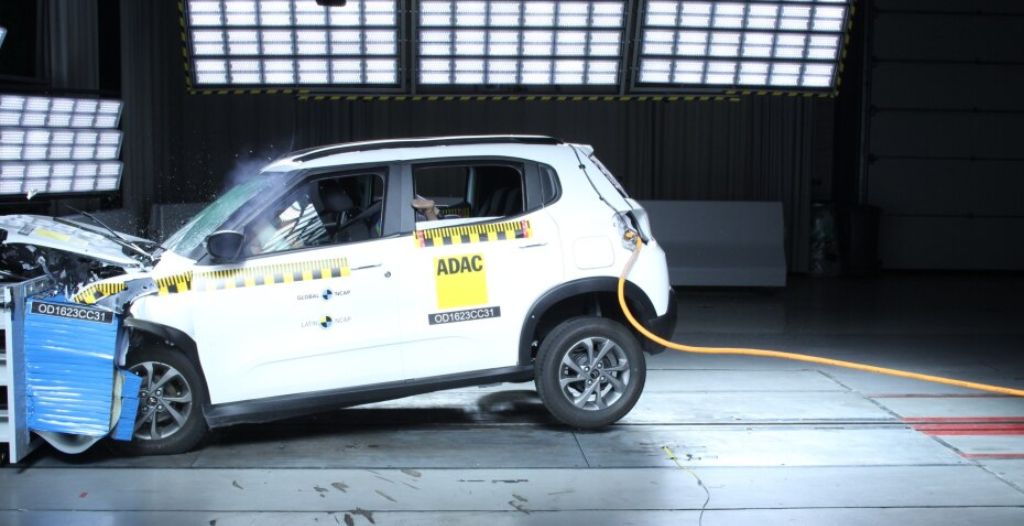When the Citroen C3 was introduced in India and Latin markets, including Brazil, it garnered attention. However, recent crash tests conducted by Latin NCAP on the Brazil-spec C3 have raised concerns, as the vehicle failed to achieve even a single-star rating. This article provides an overview of the safety equipment onboard, the crash test results for adult and child occupant protection, pedestrian protection, and safety assist, while also highlighting the status of the Citroen C3 in the Indian market.
Safety Equipment On Board
The Brazil-spec C3 that underwent crash testing featured dual front airbags, electronic stability control (ESC), seatbelt reminder, and ISOFIX child seat anchorages as standard. However, seatbelt pretensioners were absent, although seatbelt load limiters were present.
In comparison, the India-spec C3 offers a more comprehensive safety package, including dual front airbags, ABS with EBD, reverse parking sensors, front seatbelt reminders, electronic stability program (ESP), hill-hold assist, and a tyre pressure monitoring system, but these features are limited to the turbo-petrol variants.
Adult Occupant Protection
The Latin NCAP crash test resulted in a 31% (12.21 points) score for adult occupant protection in the Brazil-spec C3. The frontal impact assessment revealed good protection for the head and neck of the driver and passenger, but weak and marginal protection for their chests, respectively. Knees showed marginal protection overall, except for the passenger’s left knee, which received a good rating.
Tibias received adequate protection. The C3’s footwell area and bodyshell were rated as unstable and incapable of withstanding further loadings. The seat design was also deemed poor in protecting against neck whiplash. In the side-impact test, the C3 provided adequate protection for the head and chest, and good protection for the abdomen and pelvis. However, the side-pole impact test was not conducted due to the absence of side head protection.
Child Occupant Protection
The Brazil-spec C3 received a 12% rating for child occupant protection. In the frontal impact assessment, both rearward-facing child seats (for a 3-year-old and a 1.5-year-old) installed using ISOFIX anchorages provided good protection, preventing head exposure and contact with the car’s interior.
Side Impact
During the side impact test, both child restraint systems offered full protection. However, the C3 lost points in the Dynamic Score due to poor markings for the ISOFIX anchorages and the absence of an airbag warning when a child restraint system is installed in the front passenger seat.
Pedestrian Protection
In pedestrian protection, the C3 achieved a relatively higher result of 50% (23.88 points). The vehicle demonstrated good, marginal, and adequate protection levels in most areas. However, it scored poorly in head protection around the windscreen and A-pillars. Upper leg protection was rated as adequate to good, while lower leg protection was deemed marginal to good.
Safety Assist
The C3 received a 35% (15 points) rating for safety assist. It was penalized for lacking important safety features according to the testing agency’s standards. The Brazil-spec C3 only includes a seatbelt reminder for the driver, which falls short of Latin NCAP requirements. While ESC is present, advanced driver assistance systems (ADAS) and speed limitation devices are absent.
Citroen C3 in India
The Citroen C3 was launched in India in mid-2022, but it has not been tested by any NCAP agency yet. Once the Bharat NCAP is implemented towards the end of 2023, the C3 may receive a safety rating. In India, the C3 is available in three variants: Live, Feel, and Shine, with prices ranging from Rs 6.16 lakh to Rs 8.92 lakh (ex-showroom Delhi).
Conclusion
The crash test results of the Brazil-spec Citroen C3 conducted by Latin NCAP highlight significant safety concerns, as the vehicle failed to achieve even a single-star rating. While the C3 in India has not undergone testing yet, the introduction of Bharat NCAP may shed light on its safety performance.
It is crucial for Citroen and other manufacturers to prioritize safety enhancements to ensure the protection of occupants and pedestrians, meeting and surpassing the standards set by various NCAP agencies.
Read More:

